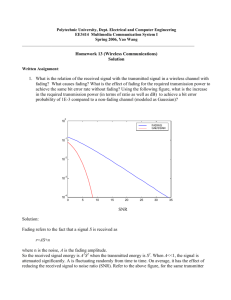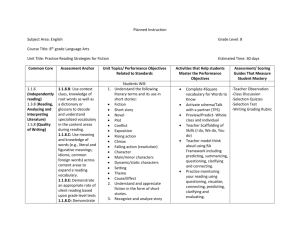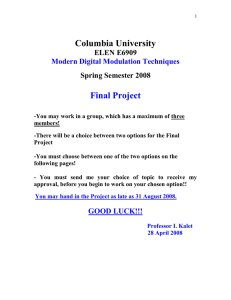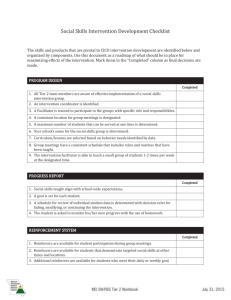Optimum Selection Diversity for BPSK Signals in Rayleigh Fading Channels
advertisement
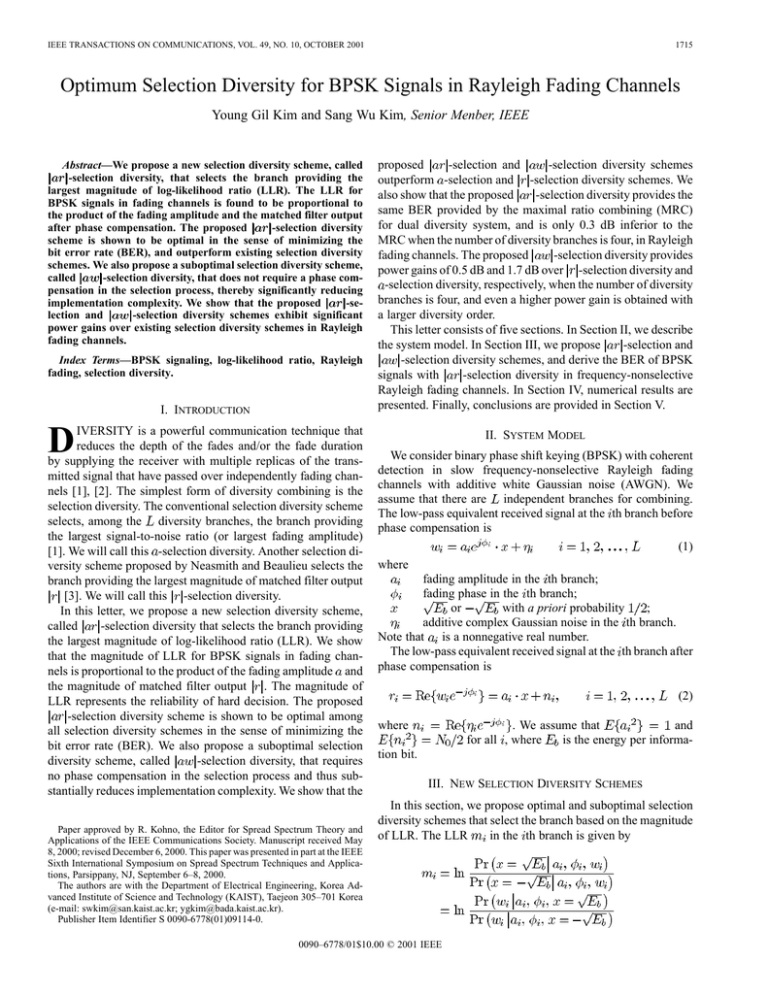
IEEE TRANSACTIONS ON COMMUNICATIONS, VOL. 49, NO. 10, OCTOBER 2001 1715 Optimum Selection Diversity for BPSK Signals in Rayleigh Fading Channels Young Gil Kim and Sang Wu Kim, Senior Menber, IEEE Abstract—We propose a new selection diversity scheme, called -selection diversity, that selects the branch providing the largest magnitude of log-likelihood ratio (LLR). The LLR for BPSK signals in fading channels is found to be proportional to the product of the fading amplitude and the matched filter output -selection diversity after phase compensation. The proposed scheme is shown to be optimal in the sense of minimizing the bit error rate (BER), and outperform existing selection diversity schemes. We also propose a suboptimal selection diversity scheme, called -selection diversity, that does not require a phase compensation in the selection process, thereby significantly reducing -seimplementation complexity. We show that the proposed lection and -selection diversity schemes exhibit significant power gains over existing selection diversity schemes in Rayleigh fading channels. Index Terms—BPSK signaling, log-likelihood ratio, Rayleigh fading, selection diversity. I. INTRODUCTION D IVERSITY is a powerful communication technique that reduces the depth of the fades and/or the fade duration by supplying the receiver with multiple replicas of the transmitted signal that have passed over independently fading channels [1], [2]. The simplest form of diversity combining is the selection diversity. The conventional selection diversity scheme selects, among the diversity branches, the branch providing the largest signal-to-noise ratio (or largest fading amplitude) [1]. We will call this -selection diversity. Another selection diversity scheme proposed by Neasmith and Beaulieu selects the branch providing the largest magnitude of matched filter output [3]. We will call this -selection diversity. In this letter, we propose a new selection diversity scheme, -selection diversity that selects the branch providing called the largest magnitude of log-likelihood ratio (LLR). We show that the magnitude of LLR for BPSK signals in fading channels is proportional to the product of the fading amplitude and the magnitude of matched filter output . The magnitude of LLR represents the reliability of hard decision. The proposed -selection diversity scheme is shown to be optimal among all selection diversity schemes in the sense of minimizing the bit error rate (BER). We also propose a suboptimal selection -selection diversity, that requires diversity scheme, called no phase compensation in the selection process and thus substantially reduces implementation complexity. We show that the Paper approved by R. Kohno, the Editor for Spread Spectrum Theory and Applications of the IEEE Communications Society. Manuscript received May 8, 2000; revised December 6, 2000. This paper was presented in part at the IEEE Sixth International Symposium on Spread Spectrum Techniques and Applications, Parsippany, NJ, September 6–8, 2000. The authors are with the Department of Electrical Engineering, Korea Advanced Institute of Science and Technology (KAIST), Taejeon 305–701 Korea (e-mail: swkim@san.kaist.ac.kr; ygkim@bada.kaist.ac.kr). Publisher Item Identifier S 0090-6778(01)09114-0. proposed -selection and -selection diversity schemes outperform -selection and -selection diversity schemes. We -selection diversity provides the also show that the proposed same BER provided by the maximal ratio combining (MRC) for dual diversity system, and is only 0.3 dB inferior to the MRC when the number of diversity branches is four, in Rayleigh -selection diversity provides fading channels. The proposed power gains of 0.5 dB and 1.7 dB over -selection diversity and -selection diversity, respectively, when the number of diversity branches is four, and even a higher power gain is obtained with a larger diversity order. This letter consists of five sections. In Section II, we describe -selection and the system model. In Section III, we propose -selection diversity schemes, and derive the BER of BPSK -selection diversity in frequency-nonselective signals with Rayleigh fading channels. In Section IV, numerical results are presented. Finally, conclusions are provided in Section V. II. SYSTEM MODEL We consider binary phase shift keying (BPSK) with coherent detection in slow frequency-nonselective Rayleigh fading channels with additive white Gaussian noise (AWGN). We assume that there are independent branches for combining. The low-pass equivalent received signal at the th branch before phase compensation is (1) where fading amplitude in the th branch; fading phase in the th branch; or with a priori probability ; additive complex Gaussian noise in the th branch. Note that is a nonnegative real number. The low-pass equivalent received signal at the th branch after phase compensation is (2) . We assume that and for all , where is the energy per informa- where tion bit. III. NEW SELECTION DIVERSITY SCHEMES In this section, we propose optimal and suboptimal selection diversity schemes that select the branch based on the magnitude in the th branch is given by of LLR. The LLR 0090–6778/01$10.00 © 2001 IEEE 1716 IEEE TRANSACTIONS ON COMMUNICATIONS, VOL. 49, NO. 10, OCTOBER 2001 (3) in (3) is the hard decision value (i.e., decide that The sign of was transmitted if , and decide that was represents transmitted, otherwise), and the magnitude of the reliability of the hard decision. Our new selection diver-selection diversity, selects the branch providing sity, called . In Appendix A, we prove that the proposed the largest -selection diversity minimizes the BER among all selection diversity schemes. Note that -level quantization (or bits) for , the required register sizes for storing the decision statistics for the MRC and for -selection, where is bits and the selected branch index, are bits, respectively. Also, the MRC requires summations, whereas the proposed -selection requires comparisons: comparison of and can be from and reading only the sign done by subtracting bit after the subtraction. Therefore, the MRC incurs a larger -selection. This computational delay than the proposed -bit is because the borrow propagation delay in the s for the subtraction operations involved in comparing -selection is smaller than the carry propagation proposed -bit summation operations delay in the involved in calculating the decision statistic for the MRC. The register size and computational delay are further increased when the Viterbi decoding is performed. with In Appendix B, we show that the average BER -selection diversity in Rayleigh fading channels is given by (4) . where the approximation in (4) is accurate for Based on the relationship in (4), we propose another new -selection diversity, selection diversity scheme, called . Note that that selects the branch providing the largest -selection diversity does not require phase information in the branch selection process, and thus substantially reduces implementation complexity. For the MRC, which provides the lowest BER among all combining schemes for fading channels with additive Gaussian noise, the combiner output is [1] (6) where and (5) was transmitted if , and otherwise, We decide that was transmitted. It should be noted that the maxdecide , dominates the sign of . imum of , the sign of is determined Particularly for and . This implies that the proby the maximum of -selection diversity yields the same BER provided by posed . the MRC for The MRC requires the fading phase information and phase compensations before combining, as indicated in (5). Similarly, -selection diversity -selection diversity require phase information and and phase compensations before selection. But -selection diversity -selection diversity do not require phase information and in the selection process. In fact, -selection diversity requires phase compensation only in one branch selected, thereby significantly reduces implementation complexity, -selection particularly for large . Also, the proposed diversity scheme has an advantage over the MRC in terms of computational delay and hardware complexity. Assuming an Note that if is substituted in (6), then we get which is the well-known average BER of BPSK signaling in Rayleigh fading channels [1]. IV. NUMERICAL RESULTS Fig. 1 is a plot of the average BER versus for several diversity schemes in frequency nonselective Rayleigh fading -selection diversity is evaluated by channel. The BER with -selection computer simulation. We find that the proposed -selection diversity schemes outperform -selection diand , -selection diversity and -selection diversity. For versity provides power gains of 2 dB and 3.1 dB over -selection diversity and -selection diversity, respectively, and is -seleconly 0.3 dB inferior to the MRC. We also find that tion diversity provides power gains of 1.7 dB over -selection IEEE TRANSACTIONS ON COMMUNICATIONS, VOL. 49, NO. 10, OCTOBER 2001 Fig. 1. BER versus E =N 1717 for L = 1; 2; 4, and 8. diversity, and 0.5 dB over -selection diversity for power gain increases as increases. . The where V. CONCLUSION We proposed optimal ( -selection) and suboptimal -selection) selection diversity schemes that select the ( branch based on the magnitude of the LLR. The LLR is found to be proportional to the product of the fading amplitude and the matched filter output after phase compensation. We showed -selection diversity scheme minimizes that the proposed the BER, and outperforms existing selection diversity schemes. The suboptimal selection diversity scheme does not require phase compensation in the selection process, thereby signif, the icantly reduces implementation complexity. For -selection diversity and -selection diversity proposed provide power gains of 2 and 0.5 dB over -selection diversity, and 3.1 and 1.7 dB over -selection diversity, respectively, in frequency nonselective Rayleigh fading channels. The power gain increases as increases. APPENDIX A PROOF OF THE OPTIMUM SELECTION DIVERSITY In Appendix A, we prove that the proposed -selection diversity minimizes the average BER among selection diversity schemes. Let be the transmitted BPSK symbol and is the is given by demodulated symbol. Then, the average BER and is the joint probability density function of It follows from (8) that is minimized by maximizing for all and , where . th branch selected th branch selected th branch selected (9) (10) th branch selected and th branch selected . Note that equality is minimized, by selecting the in (10) is achieved, and thus . In what branch providing the maximum is a monotonically follows, we show that increasing function of because (7) (8) (11) 1718 If IEEE TRANSACTIONS ON COMMUNICATIONS, VOL. 49, NO. 10, OCTOBER 2001 , then where we use the fact that and . Thus and independency between (19) (12) Since If , then (13) (20) Using (3) and where we use the equality [4] if (14) if For the derivation of , we calculate . Thus (15) . Therewhich is a monotonically increasing function of in (8) is minimized by selecting the fore, the average BER . branch providing the largest APPENDIX B DERIVATION OF (6) Here we derive (6) using the method in [3]. Without loss of was transmitted. Then generality, we assume that where . Since and s are indepen- dent th branch selected first branch selected (16) (17) (21) (18) Using (19)–(21) in (18), we get (6). Let , and . Then REFERENCES [1] S. Benedetto and E. Biglieri, Principles of Digital Transmission With Wireless Applications. New York: Kluwer Academic/Plenum, 1999. [2] M. Schwartz, W. R. Bennett, and S. Stein, Communication Systems and Techniques. New York: McGraw-Hill, 1966. [3] E. A. Neasmith and N. C. Beaulieu, “New results on selection diversity,” IEEE Trans. Commun., vol. 46, pp. 695–704, May 1998. [4] I. S. Gradshteyn and I. M. Ryzhik, Table of Integrals, Series and Products, corrected and enlarged ed. New York: Academic, 1980, p. 307.

